The 9 Best Fans Of 2023, Tested And Reviewed
Dotdash Meredith and Yahoo Inc. may earn commission or revenue on some items through the links below.
These tried-and-tested fans can stand up to the Southern heat.
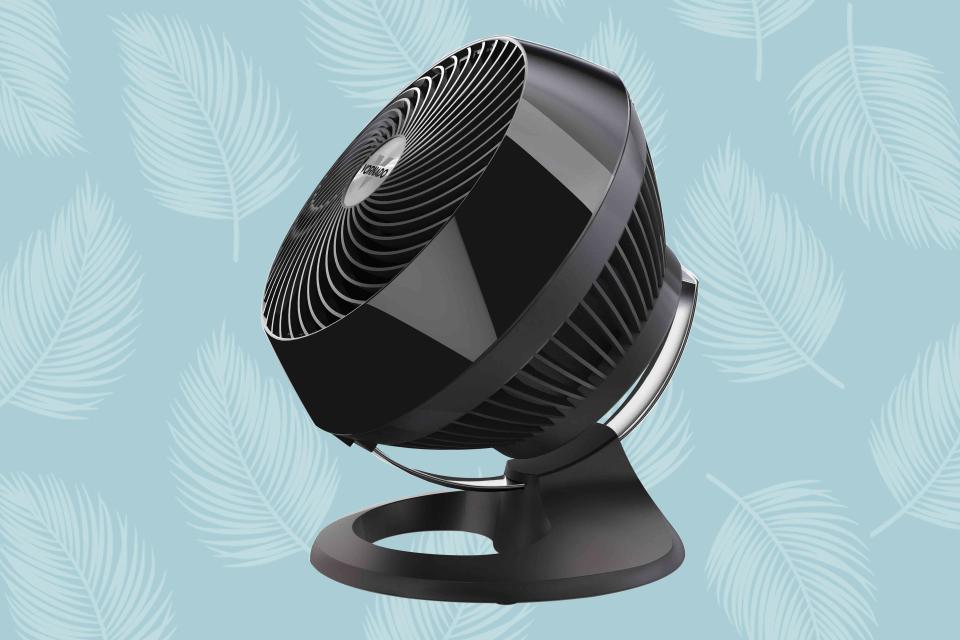
Southern Living / David Hattan
When warm weather arrives, fans are imperative to keeping you cool and comfortable without running up your energy bill—especially in the South. But there are more reasons to use a fan than just temperature regulation: “In addition to keeping you cool, a fan’s airflow also reduces the opportunity for mold and mildew within the home,” says David Charette, licensed interior designer and founding principal of Britto Charette in Miami. “This is because the movement of air removes moisture from fabric, including from upholstered furniture.”
To come up with this list, we tested 31 fans both in our Lab and at home, evaluating them on air speed, design, portability, effectiveness, and overall value. In addition to Charette, we consulted Jeff Brandlin, an electrician and owner of Assurance Electrical Services, for tips on choosing the right fan for every need.
Best Overall Fan: Rowenta Turbo Silence Extreme+ Stand Fan
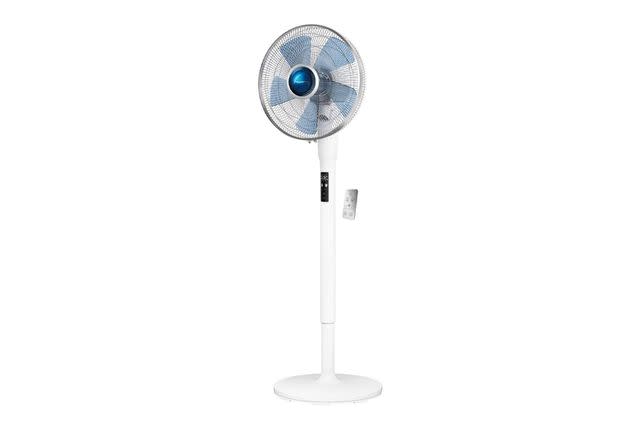
What’s Great About It
This powerful fan has a wide oscillation and a whisper-quiet operation.
What Could Be Better
It’s not the most portable option and takes up a fair amount of space.
Putting the Rowenta Turbo Silence Extreme+ Stand Fan at the top of our list was an easy choice because of how cool it made our room on hot days—even without AC. This corded electric fan has five speeds, which are activated by pressing plus and minus buttons on a remote control. The manufacturer says that this model is the most silent fan in its line—which we can definitely attest to, as we found it to be very quiet for a stand-up fan. The motor sound was subtle on lower settings, and even when we set it on the highest setting, it was still barely noticeable. More importantly, the fan was very effective in distributing air around the room. Whether we were 6 inches, 6 feet, or 20 feet away, we felt the breeze from all angles of the room.
The fan consists mainly of metal and features a modern industrial design. This makes it durable, but probably won’t match the decor in your room. Still, it does what it needs to do, and we would not be bothered by it if it was in our living room or placed somewhere in a corner. We like that its stand is over 3 feet high, and feels rather heavy—it would be hard for small children or pets to mess around with it.
Overall, we found the fan to be pricey but worth it because of the value it offers for people living in warm parts of the country. But, if you’re living in a place where you only need a fan for a few months out of the year, we suggest waiting for a sale to buy it.
Price at time of publish: $180
Type: Standing | Oscillation: 120 degrees | CFM: 2,400
Best Budget Fan: Pelonis 16-Inch Pedestal Fan
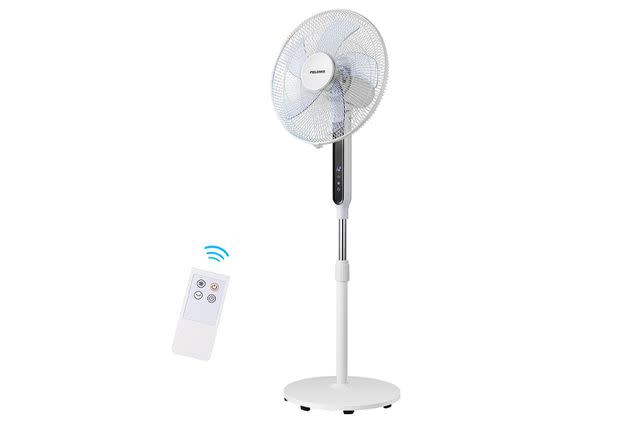
What’s Great About It
The height is adjustable so you can direct the airflow where you need it most.
What Could Be Better
You have to cycle through all the settings to get to the setting you want.
With over a dozen settings, this sleek Pelonis fan is a prime pick to keep your home cool. We found that on its highest settings, the breeze could be felt from up to 20 feet away. The fan features a high-quality metal build with clear plastic blades and a heavy base that keeps it stable when it's on. And at 38 decibels on the lowest setting, it’s super quiet, and we found that it hardly made any noise even when it was on full blast. Take note that you’re not able to press a button to go directly to the speed you want. Instead, you have to cycle through all the settings to find what you need. However, it shouldn’t be too much of an issue as changing the speed is pretty quick and you’ll see it displayed on an LED screen as you click through.
It’s a standing fan that is height-adjustable up to 16 inches, so you can get the most air whether you’re sitting, standing, or lying in bed. This fan both tilts and oscillates, which gives you wide circulation no matter the size of your room. If you plan on running the fan for an extended period of time, it comes with a built-in safety mechanism that will automatically turn your fan off when the motor overheats. Be aware that the handles are close to the blades, so you’ll need to be extra careful when you want to move the fan.
Price at time of publish: $80
Type: Standing | Oscillation: 90 degrees | CFM: 1,595
Best Tower Fan: Better Homes & Gardens 40" 3-Speed Tower Fan
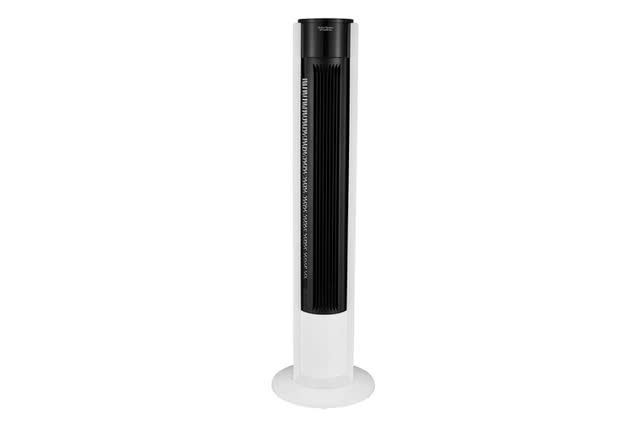
What’s Great About It
The internal oscillation provides a wide range of airflow.
What Could Be Better
It has a tendency to wiggle while running and can feel unstable.
This affordable tower fan comes with three speed settings and three “wind modes,” for a total of six different configurations. It also features a 60-degree internal oscillation (the blades move not the head) which is not the norm for many fans. While it wasn’t really noisy, it did have a tendency to wiggle a bit while running, and the base feels a little unstable. However, it still held up to six months of regular use. In terms of portability, the fan is lightweight and comes with a sturdy handle, which makes it easy to move from room to room.
There is also an automatic shut-off timer that you enable by pressing buttons on the fan or by remote control. Not to mention, an LED display with four pre-set time options. Just so you don’t lose your remote, the fan comes with a magnetic pad on the base where you can stick the remote when you’re done using it. Better Homes & Gardens is owned by Southern Living’s parent company, Dotdash Meredith.
Price at time of publish: $60
Type: Tower | Oscillation: 60 degrees (internal) | CFM: 1,165
Best Fan for Bedrooms: Vornado 660 Large Air Circulator
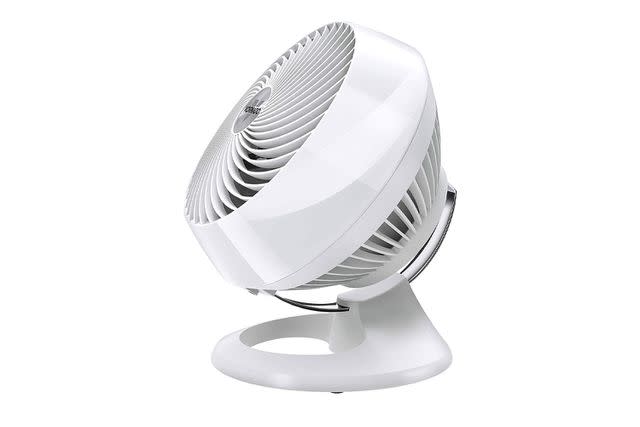
What’s Great About It
The air circulation technology means you don’t have to stand in front of the fan to feel its cooling effect.
What Could Be Better
It doesn’t come with a remote, nor does it have a handle for carrying.
For hot sleepers, an effective fan like the Vornado 660 Large Air Circulator is what you need to keep you cool all night long. Instead of an oscillating head, it uses Vortex's signature air circulation, which is powerful enough to keep rooms of all sizes cool. To do this, it releases a stream of air that flows in a spiral pattern while simultaneously drawing in fresh air from behind, using the walls and ceilings as pathways for constant air circulation. This means you don't need to be standing directly in the fan's path to feel its cooling effect.
After a month of use, we found that not only did it do a great job in circulating air around the room, but it was also one of the few options on our list that produced an airflow we could feel from 20 feet away. Even though the head doesn’t completely rotate, it still moves up and down. Plus, it has four speeds, so you choose how hard or soft you want air to blast.
The size is suitable for the floor or a tabletop or dresser. The only minor snafu we noticed is that it lacks a handle, and is not convenient to carry around. Plus, the Vornado doesn’t have a remote, which is surprising for a fan at this price point.
Price at time of publish: $97
Type: Floor/Table | Oscillation: None | CFM: 584
Best Window Fan: Genesis A1 Window Fan
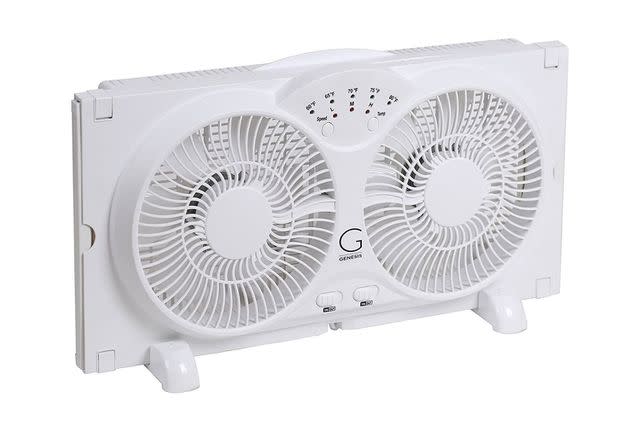
What’s Great About It
The reversible airflow lets you choose whether you want to intake or expel air from the room.
What Could Be Better
It’s somewhat loud and can be difficult to switch from the window to standing mode.
Compared to other fans, window fans have an advantage because they suck in cool air from outside to blow inside your room. For anyone with the right-sized window, the Genesis A1 Window fan could be incredibly useful. While this wasn’t the most powerful fan we tested, it was easily able to cool the room on its higher settings. If you’re not sure if the fan is big enough for your window, it expands up to 6.5 inches on both sides. And while it can prevent small- to medium-sized rooms from feeling stuffy, it may not have enough reach for larger rooms.
The fan comes with low, medium, and high settings, as well as an adjustable thermostat. The fan’s airflow is reversible, so you can choose whether you want to intake or expel air from your room. Noise-wise, it’s loud, so it’s probably not a good choice to use for the bedroom.
Despite its size, it was still portable and had a handle on it for easy carrying. Although, we found switching it from window to standing mode to be difficult. Overall, we found this to be an excellent option if you live in a temperate climate (like the South) and plan on permanently keeping it in your window.
Price at time of publish: $50
Type: Window | Oscillation: None | CFM: 706
Best Box Fan: Pelonis 3-Speed Box Fan
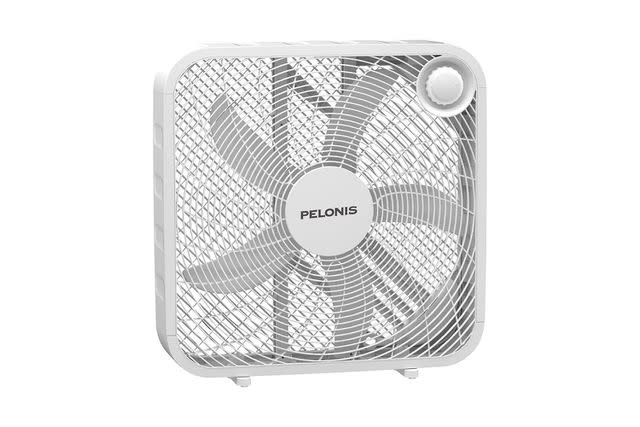
What’s Great About It
It’s large enough to cool rooms of all sizes and easy to carry from place to place.
What Could Be Better
The fan is very noisy and may be disruptive to sleep or conversations.
When the days are hot and humid, a fan like the Pelonis 3-Speed Box Fan can give you some relief. It’s a 20-inch fan that works well anywhere it goes. Whether you want to fit it in a window or place it on the floor, this fan provides adequate ventilation. In terms of effectiveness, we gave it full marks because it offered powerful airflow which you could feel even if you were not standing directly in front of the fan. While we felt best when the fan was 6 feet away, we were still able to feel it at 20 feet away. For large rooms, like a living room or master bedroom, this fan is ideal. The trade-off is that the fan is really loud, and it might be hard to have a conversation with someone when it’s running.
You won’t find any extras such as digital interfaces or remote-controlled operation on it—which is not surprising considering its price. But, it does have two handles to make it easy to move around. As fans go, it’s a high-quality option that’s designed for function over fashion. But, if you need something more compact or need an oscillating option, you should check out other fans on our list.
Price at time of publish: $45
Type: Box | Oscillation: None | CFM: Not listed
Best Bladeless Fan: Dyson Pure Cool Purifying Fan
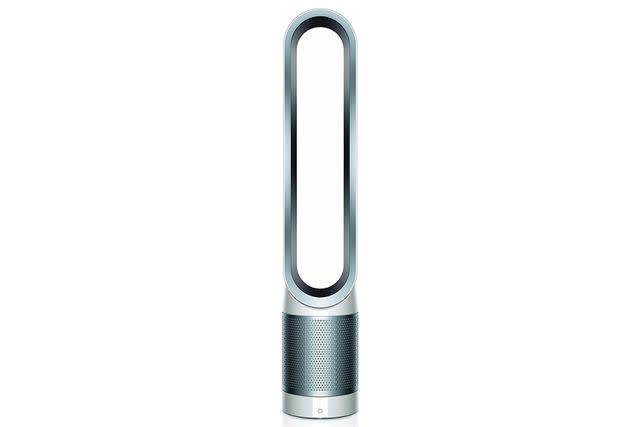
What’s Great About It
It simultaneously purifiers and cools air without any blades.
What Could Be Better
It doesn’t generate the strongest breeze.
If you have small children and don’t mind paying a premium price— a PTPA (Parent Tested Parent Approved) fan like the Dyson Pure Cool TP01 is a safe pick for your home. It’s completely bladeless, which means that air circulates via an inner motor that pulls air in and then pushes it out through ring slits on the fan.
The fan provides plenty of cooling options and features ten settings and two types of airflows (diffused and focused). In addition, it’s much quieter than your typical box fan or AC unit, which makes it ideal for bedrooms. It also oscillates up to 70 degrees, which is wide enough to hit all corners of a room. However, we did find that we had to blast it on the highest settings in order to really feel the breeze.
The Pure Cool is the only fan on this list that comes with a HEPA filter, which means that it emits purified air. If you suffer from allergies or asthma, this will be an excellent choice, as it can trap 99.9 percent of particles, such as pollen and pet dander. There is also a built-in timer that you can program to switch off after set times. While we don’t think it is as strong as the other tower fans on our list, it blends well with any room decor.
Price at time of publish: $430
Type: Bladeless tower | Oscillation: 70 degrees | CFM : 869
Best Fan With Heater: Lasko FH500 Fan & Space Heater Combo Tower
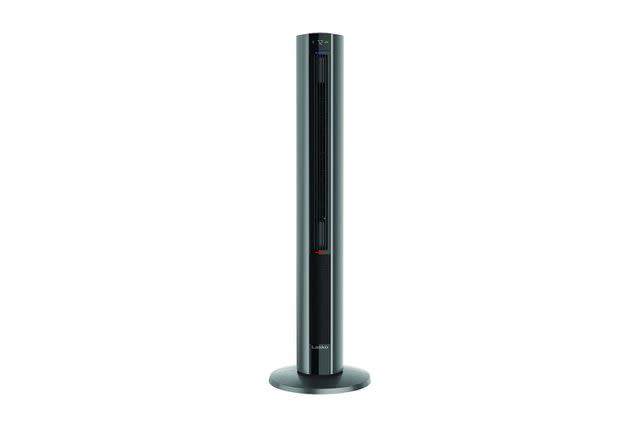
What’s Great About It
It can blow both hot and cold air, making it great for all-season use.
What Could Be Better
The cord is short, so we weren’t able to place the fan more than a few feet away from the power outlet.
If you’re looking for a fan that’s versatile, the Lasko All-Season Tower Fan and Heater easily fit the bill. It blows both hot and cold air, so you can use it all year round—and it will save you from having to spend money on a separate space heater. We were surprised at how effortlessly it was able to cool down the room. It circulated air so effectively that while the fan was running, we didn't feel the need to turn on the air conditioner until around midday.
It features a metal body, which is always a good indication that it's built to last. Plus, it has a bladeless design, which makes the fan lighter and safe to have around small children or pets. Additionally, there is an automatic shut-off feature that activates if the fan is accidentally knocked over. Although the fan isn't completely silent, its hum is hardly noticeable and seamlessly blends into the background, allowing you to watch a movie, chat with friends, or work without disruption.
If you want to keep it running smoothly, it’s recommended you clean the filter every two weeks plus at the end of every season. Keep in mind that the cord is quite short and we weren’t able to place it more than a few feet away from the power outlet.
Price at time of publish: $163
Type: Tower | Oscillation: 90 degrees | CFM: 350
Best Desk Fan: Crane Circulating Desk Fan
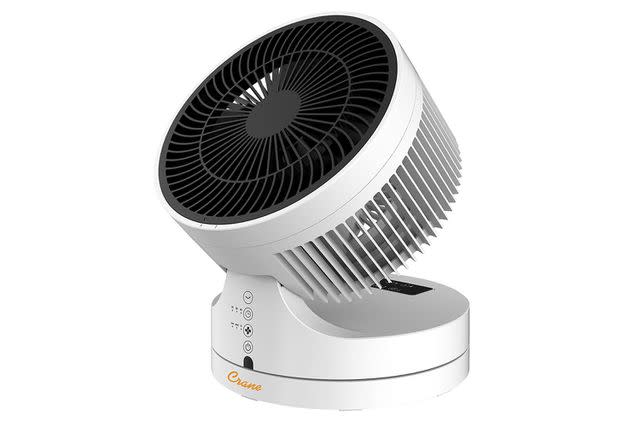
What’s Great About It
This small but mighty fan can be adjusted to oscillate at different angles.
What Could Be Better
It may take up too much space on a small writing desk.
While the all-plastic Crane Circulating Desk Fan looks like your average fan at first glance, it actually has lots of added features that many will find beneficial. What’s more, this fan’s performance impressed, and we gave it the highest marks possible for effectiveness and value.
We encountered no hiccups with this fan in terms of its operation or performance. However, it does emit a soft whirring sound while running. The fan has three standard speed settings: low, medium, and high, which can be adjusted to blow at specific angles while oscillating. You can stream air straight to the ceiling, at a 45-degree and a 90-degree angle. Additionally, you can switch settings using the included remote control.
Even though it’s expensive for a desk fan, we found that it does a really good job of keeping us cool, which makes it worth the price. Although if your desk is small, it is going to take up a fair amount of workspace. That being said, you can fold down the head to make it more compact and easy to store. We don’t think it will be much use to you as a main fan—unless you’re living in a small apartment. But if you‘re looking to use less AC or need additional fans for your bedroom or home office, this is a suitable option.
Price at time of publish: $50
Type: Desk | Oscillation: 70 degrees | CFM: Not listed
The Bottom Line
Our top pick is the Rowenta Turbo Silence Extreme+ Stand Fan. It’s a durable standing fan that has enough power to cool a large room. And it’s whisper quiet, making it a great choice for the bedroom, too. For a more budget-friendly pick, the Pelonis 16-Inch Pedestal Fan is just as good in many ways. It’s also a standing fan that’s height-adjustable up to 16 inches and has 12 different speeds. Additionally, it features an LED touchpad, which makes it easy to change settings.
More Fans to Consider
Honeywell QuietSet Whole Room Tower Fan: From 6 inches away, this fan felt super powerful when we turned it to the highest speeds. But, the airflow greatly diminished the further away we went from it. And although the main body felt premium, we wished that it had a more stable base.
Lasko Wind Curve Tower Fan: Despite the tall and modern-looking Lasko Wind Curve Tower Fan only having three speeds, it provides lots of air circulation and feels really good on a hot day. Plus, it comes with a programmable timer. Obviously, because of its size, you might have some issues with portability. But it does have a handle that you can use to carry it. We also wish it came with a spot to dock the remote.
Our Testing Process
We tested 31 fans across a variety of categories, including standing fans, tower fans, box fans, and more. All fans were first tested in our Lab and then brought home for long-term testing. Each was evaluated on air speed, design, portability, effectiveness, and overall value. To test for airspeed, we used an anemometer to record the speed, taking note of the number of speeds, the control mechanism, and the noise level.
To evaluate the design of each fan, we considered what features made the fan more practical or convenient to use. We tested to see if our fans had oscillation, height adjustment, or other built-in features to direct airflow. In addition, we noted whether the fan came with accessories or features, such as a remote, timer, or smart features. We also considered the portability of each fan, taking into account its size, weight, handles, and the sturdiness of its base.
The real test of each fan is how well it's able to cool a room. To test for this, we stood directly in front of the fan from three different distances—6 inches, 6 feet, and 20 feet—and recorded at what distance the airflow began to diminish. Finally, we received the price of each fan, and rated its performance relative to its cost. After Lab testing was complete, we brought the fans home and tested them for up to six months, providing insights as to how well they held up to daily use.
Tips for Choosing the Right Fan
Type
There are lots of fans you can furnish your home with, but the most common fans are standing fans (aka pedestal fans), tower fans, box fans, window fans, and desk fans. You can also get bladeless versions, such as the Dyson Pure Cool TP01, which are generally safer and are a good pick if you have small children or pets in the home.
Standing fans, like our best overall pick, feature a large fan head on an adjustable stand. These fans are usually oscillating and have a wide range of airflow and a powerful output. Tower fans, on the other hand, are tall, slim fans stationed on a base that oscillates. They tend to have quieter operation, making them great for the bedroom (although they aren’t as powerful as standing fans).
Box fans are powerful and easy to carry from room to room, but they tend to be quite loud and not the most discrete in terms of appearance, either. Window fans are designed to be tucked into a window frame and work by pulling in outside air (our favorite window fan, the Genesis A1 Window Fan, exhausts indoor air, too). They make a great space-saving option, just keep in mind that it’s not recommended that you operate them while it’s raining. Finally, desk fans are compact tabletop fans that are designed to be used at close range, so they usually produce a softer breeze.
CFM
CFM stands for cubic feet per minute and refers to the volume of air that a fan can move. Typically, larger spaces require fans with higher CFMs to cool a room effectively. As a general rule of thumb 1 CFM is equal to 1 square foot of room coverage. So, for example, a 500 CFM fan should cover a 500 square-foot room.
Noise Output
How much noise you tolerate comes down to where you place the fan. “If you’re in a bedroom, the noise level of course should be low,” says David Charette, licensed interior designer and founding principal of Britto Charette. “But for outdoor applications like balconies, patios, and outdoor restaurant seating, it’s not so important because the decibel level is dissipated.”
Fan Speeds & Settings
Depending on the fan you buy, fan speeds and settings can vary. While most fans will have at least three basic settings (low, medium, and high), there are fans that have 10 speeds or more. Charette says that when deciding on a fan shoppers should factor in how much time will be spent in the room and where they intend on putting it. “A high-speed setting is a great way to remove or dissipate cooking odors,” he says. Even in cases when you plan on not being there, having some type of air movement is necessary to keep your room free from moisture and mold. “Is this a vacation home where you’ll be gone for long periods of time? A fan with a low-speed setting to continuously move the air is a good option,” he says.
Charette also adds that another reason why it’s important to keep air moving with AC and fans during the summer, even if you’re away from home, is to preserve the wall covering. “If room temperature and humidity rise too high, the wall covering can fail,” he says. Homes in very humid climates can benefit from also using a dehumidifier.
Oscillation
Oscillation is the back-and-forth movement of a fan’s head, which helps to circulate air throughout the room. “With oscillation, airflow gets distributed more effectively across a room, " says Jeff Brandlin, electrician and owner of Assurance Electrical Services. “Instead of blowing air in a single direction, an oscillating fan can reach more people and create a more comfortable environment.” He adds, “The movement of an oscillating fan helps mitigate temperature variations, which keeps you feeling cool and comfortable.”
While it’s a common feature in many fans, not all fans have oscillation. Box fans and window fans offer no oscillation, but you’ll notice that they’re more likely to have powerful airflow to make up for it. Due to their design, bladeless fans and some tower fan models lack oscillation as well. And among those fans with oscillation, there is variation in the range—those on our list oscillate anywhere from 60 degrees to 120 degrees.
Questions and Answers
What is the lifespan of a fan?
According to Brandlin, this can vary depending on factors such as the quality of the fan, usage frequency, and maintenance. He says, “On average if you take good care of your fan, it can last anywhere from 5 to 15 years!”
How much does a fan cost?
“The good news is that you don't have to break the bank to keep cool,” says Brandlin. “Basic pedestal or table fans are affordable, usually costing between $20 to $50 while fancier ones like a tower or bladeless fans can go on for anywhere from $50 to $200 or more.”
Where is the best place to put a fan?
Brandlin has several tips for homeowners who want to maximize the cooling effects of their fans. He suggests placing fans near open windows or doorways to help fans draw in cool air and improve circulation. “When you position your fan across from an open window, you create a cross-breeze, drawing in fresh, cool air, and pushing hot, stale air out,” he explains.
He also said that nothing should be in front of your fan that could potentially stop air from circulating. “Make sure there are no fabrics, curtains, or furniture blocking your fan. Otherwise, the airflow can become restricted, and it loses its cooling potential,” says Brandlin.
If you want direct cooling, he says, “Point your fan towards the areas where you spend the most time. The fan airflow directed towards people's seating areas, workspaces, or beds will provide direct cooling and enhance comfort.”
Factors such as elevation and your fan’s oscillation play a role as well to help cool any room. Brandlin says that an elevated platform such as a table or stand can disperse airflow more efficiently throughout the room. He adds, “The oscillation feature of your fan is also useful—you can cover a broader area and significantly improve overall air circulation.”
Why Trust Southern Living?
Nor’Adila Hepburn is a writer based in North Carolina who specializes in writing product reviews. To determine the best fans, we tested 31 fans in our Lab and at home, evaluating them on air speed, design, portability, effectiveness, and overall value. Nor’Adila also spoke to David Charette, licensed interior designer and founding principal of Britto Charette, as well as Jeff Brandlin, electrician and owner of Assurance Electrical Services.
For more Southern Living news, make sure to sign up for our newsletter!
Read the original article on Southern Living.

